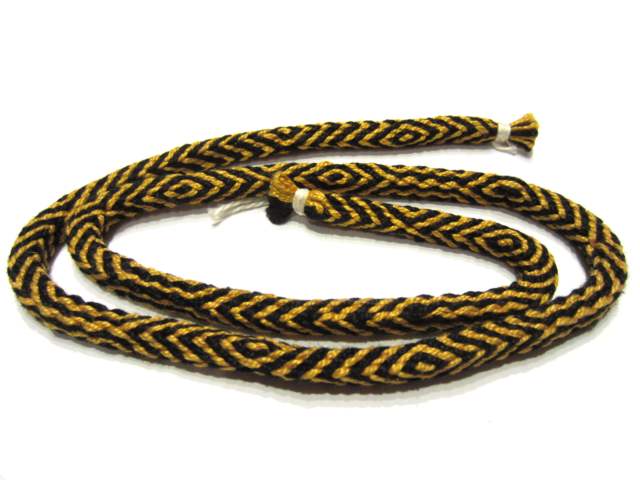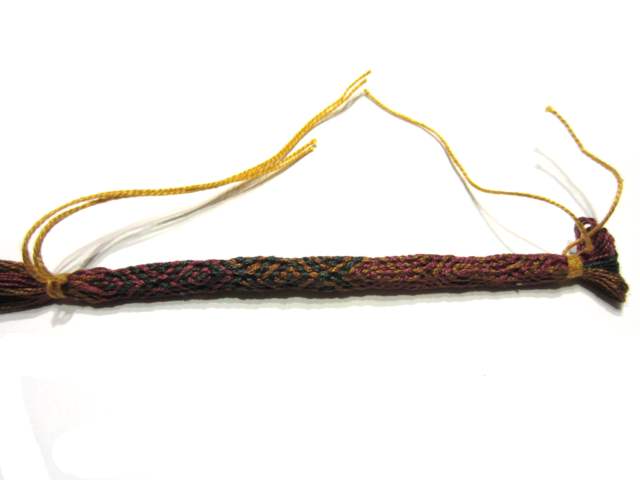This post is titled:
Class Braids 2013
Rodrick Owen was back at The Mannings again this year to lead a two-day braifing workshop. Sharon bought me a slot in the class for my birthday! She also bought a slot for herself, of course. We really enjoy being the only husband/wife pair when we take classes together. Anyway, here are the braids.
First, this is the braid I had to take off my marudai so I could use it in the class. This is a 32-strand flat braid done in silk/bamboo yarn. It's the closest approximation to the traditional Japanese "Kikko" braid that I have ever seen a marudai pattern for. A braider named Michael Hattori says that Rodrick Owen gave him this pattern back in the eighties, so it ties into the theme of this post.
The right end of the braid was the starting end, and you can see that it took me a little bit to figure out how to get the tension right. You really want to pull tightly on steps 1 and 5 of this 8 step braid if you want everything to pull together.
This was the braid I did on Saturday of this 2-day workshop. It's a 24-strand square braid made on a standard marudai. This braid is essentially a warm up for the core braid I was doing the next day. It looks complex from this angle, but you are really just working six simultaneous 4-strand braids. Most of you probably think that doesn't simplify anything, but it really does, trust me. Each of the braids goes through a series of rotational moves, then crossover moves, then opposite rotations to reverse the pattern. The "eyes" in this braid are formed by the crossover moves, so doing multiple corssovers in a row extends the eyes as you can see in several places.
The keen eyed will notice two errors in this braid. The larger one was due to a misplaced strand that threw off the color repeats. The smaller one looks like it must be a duplicated step athe the wrong time. With this braid, you have to keep track of not only what you are doing, but what you are planning to do next.
This braid didn't come out very smooth, but you can see it getting smoother as it goes to the left, which is me getting better. Sorry about the low-contrast color scheme I unwisely chose. For this braid, 12 of the 36 strands are up on hooks over the marudai, and you braid the square braid around them. After a couple of eyes, you switch out one color (purple in this case) for the threads up on the hooks (green) creating the color change you can see in the braid. You do a couple more eyes, then do another color change (gold to purple) after hours of set-up and braiding, I called it quits for the day and spent the rest of the time cleaning up and asking Rodrick Owen questions.
He has a book on these core braids coming out later this year. The book has instructions for building the core stand, and instructions for making dozens of fascinating braids on the marudai or disk. I built my own core stand last month in anticipation of this class, but I had to field modify it because of some misconceptions I had. Rodrick says many core braids may actually be simpler on the card/disk than on the marudai, so good news for all you card/disk braiding fans. The samples he brought to show us of the braids that are in the book are just amazing. I know a lot of people are waiting for this book with 'bated breath.
2013.04.08 at 12:00pm EDT
All text and graphics copyright © 2007-2013 Elliott C. Evans except where otherwise noted.
[Visit my web site] [Subscribe via RSS]




